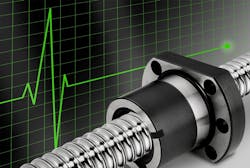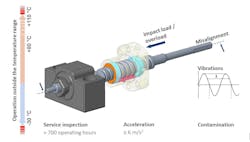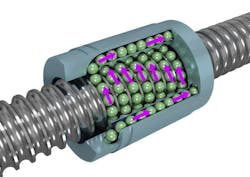Eight Red Flags to Avoid for Longer Ball Screw Life
Premature failure of a ball screw in the field can lead to unnecessary downtime and other unpredictable consequences. However, the signs indicating potential failure are often unclear (Figure 1), and if there is a problem, time-intensive and costly troubleshooting may be needed.
For example, it may be necessary to remove the ball screw or even the entire ball screw drive assembly from a machine. Users can avoid such inconveniences by paying close attention to seven important installations, operating and maintenance issues that can shorten the service life of a ball screw.
1. Misalignment/Bearing Type
Failure to comply with specified installation tolerances is a frequent cause of premature failure of a ball screw. The required tolerances can usually be found in the installation instructions. The amount of misalignment varies depending on the diameter of the screw, stiffness of preload and length of the screw. Linear screws should always be supported radially and axially. Improper alignment can cause lateral forces and bending moments into the system.
READ MORE: What’s Up With Customization?
2. Critical speed
Any vibrations that may occur must also be considered. Every ball screw has a rotational speed at which the vibrations and resonance oscillations become excessive (Figure 2). This “critical speed” depends on the length and diameter of the screw, and the type of mounting or end fixity used. Exceeding that critical rotational speed may result in excessive vibration, which can cause damage or noise. For optimal performance, best practice is to operate below 80% of the screw’s critical speed.
The possible mounting types correspond to the known Euler cases:
In the cases mentioned above, the critical speed increases from top to bottom. Therefore, the type of mounting or end fixity can be deliberately selected to handle higher speeds. The unit should also be correctly aligned with the drive, support bearings and load to ensure optimum performance and service life.
3. Shock/Overload
Non-axial as well as linear impacts lead to lateral forces that have a negative impact on the system. A collision with a heavy or stationary obstacle can exceed the maximum permissible surface pressure in the contact area between the ball nut or ball screw (Hertzian pressure) or even destroy the raceway. This can result in deformation or chipping (pitting). Shock (or overload) can happen as easily as driving the ball nut into a hard stop or travel obstruction. Electrical motors, such as servo or AC motors, can generate torque levels that far exceed the capabilities of the ball screw. Care should be taken to prevent excessive torque being applied to the ball screw.
READ MORE: Unleashing the Capabilities of the Linear Servo Press in Manufacturing
4. Contamination
Due to the rolling friction of the balls, ball screw drives have a low coefficient of friction. The load is transmitted via a small contact surface between the ball and the screw (Figure 3). This means that the slightest contamination of these surfaces has a major influence on the overall system. Friction increases, and more power must be supplied. The increasing friction can also cause heating. If abrasive particles enter the ball screw drive, they can destroy the surfaces of the ball and challenge the integrity of the raceway contact, resulting in clogging and early system failure. This can, for example, happen with abrasive sands generated by stone-crushing machines or fine wood dust from timber cutting.
5. Exceeding Acceleration and Speed Limit Values
To ensure optimum use of the ball screw, acceleration and speed limits should not be exceeded. Thomson Industries, for example, recommends a maximum acceleration of 6 m/s². The critical speed of the ball screw, which depends on the bearing arrangement and the ball nut, constrains the travel rate. Ball nuts have an additional speed limitation due to the maximum velocity of the ball bearings and their internal motion geometry. In individual cases, higher values are also possible under certain conditions. However, these should be clarified with the manufacturer in advance. If the acceleration is too high, there is a risk that the balls will not roll but instead slip, thus destroying the balls, raceway and return systems.
6. Operation Outside the Temperature Range
Operation outside the ambient temperature range specified by the manufacturer can lead to a reduction in a ball screw drive’s service life. For example, the ball screws from Thomson are designed for continuous operation from −30°C to 80°C (−22°F to 176°F) though the maximum temperature can be increased to 110°C (230°F) in the short term. If other temperature ranges need to be implemented, this can be achieved through an individual material selection or other options.
READ MORE: Thomson Industries Offers Upgraded Actuator Selection Tool
7. Failure to Comply with Maintenance Intervals
If the maintenance intervals recommended by the manufacturer, such as regular re-greasing after 700 operating hours, are not adhered to, the service life of the system can be significantly shortened. If access to the lubrication openings is difficult, an automatic lubrication system should be provided during the design and planning phase.
8. Insufficient Condition Inspection
To avoid downtime and maximize unit life, ball screw inspection should be performed at regular intervals. The following inspection tips can help detect signs of potential premature failure:
- If metal chips are visible on the screw raceway or in the lubricant, this may indicate increased wear or a defect in the balls. The axial play should be measured to deduce the wear of the components.
- Check the raceways for wear, spalling (Figure 4) and contamination.
- Check the spindle for sufficient grease and observe maintenance intervals of a maximum of 700 hours.
- Check that all connections are tight and that there is no excessive vibration.
- Check the drive system for constant drive torque and the ball screw drive for optimum running smoothness.
- Listen for unusual operating noises. The noise level should not be higher than on the day of commissioning. The movement of the ball screw nut should be smooth and without resistance. Any change in the noise level or the “running feel” indicates internal damage.
Attention Pays
Ball screws are the most deployed technology for converting rotary motion to linear motion, but they are subject to many factors that can result in premature failure, including misalignment, shock overloads, contamination and lax maintenance. By adhering to installation guidelines, monitoring operational conditions and performing regular inspections, users can keep systems operating at peak performance, thereby reducing the risk of premature failure, avoiding costly downtime and fulfilling application requirements.








